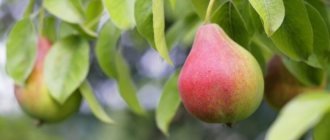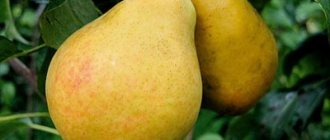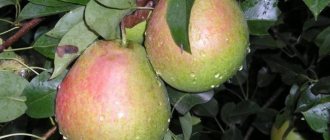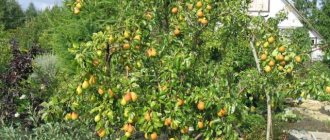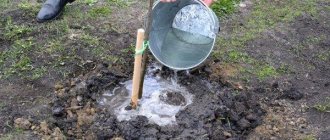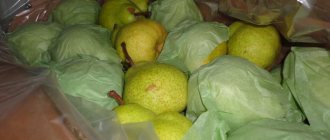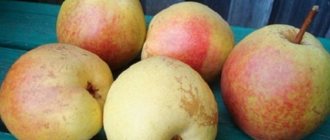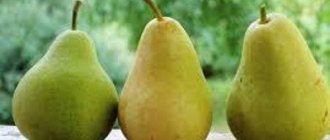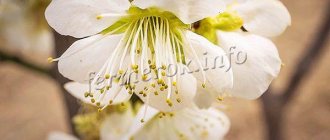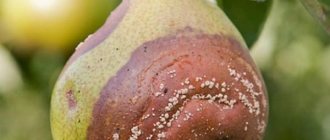When eating pears regularly:
- The body's ability to resist various infections increases.
- The likelihood of seasonal depression is reduced.
- The amount of sugar in the blood decreases in diabetes.
- The functioning of the heart, kidneys, and liver improves.
- Inflammation of the urinary tract is reduced.
- Improves appetite and digestion.
- Pear compotes help fight severe coughs.
Scientists, knowing about the usefulness of pears, have been working for centuries to create new varieties that could surpass their predecessors in taste and disease resistance. The Victoria pear variety is an excellent result of the complex work of breeders.
History of selection and region of breeding
The Victoria pear variety was first discovered by leading breeders of the Institute of Irrigated Horticulture I. N. Boyko, P. V. Grozditsky, E. A. Avramenko, G. I. Kulikov. The new variety appeared as a result of crossing two varieties of pears: Bere Bosk and Tostobezhka. The variety was bred in the south of Ukraine, so the pear very easily adapts to life in the steppes and forest-steppe. Victoria can withstand drought and heat and is a summer pear variety.
The summer group of varieties also includes: Limonka, Kosmicheskaya, Ilyinka, Carmen and Detskaya.
Landing
When choosing a place to plant a seedling, preference should be given to well-lit areas. Recommendations on the preparation of the planting hole and technology for planting Victoria pears can be found in the articles selected below.
How to plant a pear tree correctly
At what distance to plant pears?
How to choose pear seedlings
How to replant a pear
Pear "Victoria": description of the variety and photo
Victoria pear grows to medium size.
The crown of the tree is shaped like a cone with a flattened top. The fruits have a characteristic pear-shaped shape. Ripe pears look very attractive: a delicate pink blush appears. The peel is smooth and thin: numerous subcutaneous points are clearly visible through it.
The pulp of pears does not have pronounced granulation, is white, and exudes a light aroma .
Pears are securely attached to the branches of the tree using a long and curved stalk.
You can visually familiarize yourself with the Victoria pear in the photo below:
Advantages and disadvantages
"Victoria" is distinguished by a huge number of advantages highlighted by gardeners. Of course, there are some minor drawbacks. It is very important to consider both to understand whether you want to grow it on your site.
pros
- Stable yield, characterized by abundance and high quality.
- Excellent taste characteristics and good presentation.
- The collected fruits can be consumed for at least a month.
- Representatives of this species are not afraid of frost and drought.
- Good immunity to scab.
- Not afraid of most parasites.
Minuses
There are no pronounced shortcomings; only a slight precociousness can be identified. Some gardeners say that due to cold weather and rain, the taste characteristics of the fruit deteriorate. Also, young seedlings must be covered for the winter.
Characteristic
Victoria pear is a table variety: excellent taste is combined with a very attractive appearance of the fruit. The pears are very juicy, sugar content (7.8%) prevails over acidity (0.4%). Experts rate the taste of pears at 4.5 points. The fruits are stored in refrigerated places for only a few months, so they should be consumed first.
The following pear varieties can boast of excellent taste: Kupava, Krasulya, Lada, Dekabrinka and Dessertnaya Rossoshanskaya.
Productivity
The Victoria variety produces the first harvest no earlier than the first six years after planting. Spring frosts do not harm the Victoria pear: this variety is characterized by late growing season and flowering . Thanks to this feature, a lot of fruits are set, and every year you can count on a bountiful harvest. Pears grow large, some specimens reach 430 grams, average fruit weight: 250 grams. An adult tree can produce annually .
The following varieties also demonstrate excellent productivity: Tatyana, Quiet Don, Lesnaya Krasavitsa, Noyabrskaya and Lel.
Frost resistance
Mature trees can easily tolerate even very severe frosts.
There are also other varieties of pears that are frost-resistant, such as: Thumbelina, Lira, Nika, Otradnenskaya and Perun.
Only seedlings require the gardener's attention. A layer of mulch needs to be distributed on the ground around the young tree: it will at the same time additionally fertilize the plant and provide insulation during severe frosts.
If the branches of the pear are still very thin, then for the winter it is recommended to tie them together with the trunk so that strong winds in bad weather do not cause irreparable damage to them.
The trunk can be tied to a peg, thereby providing the tree with even greater stability.
Main characteristics
The tree is of medium height, although sometimes tall. The crown is not too dense and has the shape of a rounded pyramid. The buds are mainly tied on the ringlets. After winter, awakening and flowering occurs late, therefore, the flowers do not suffer from cold weather.
Experts characterize the variety as frost-resistant, not afraid of drought and scab. They classify it as summer.
The culture is self-sterile and has a tendency to form fruits without seeds.
Gardeners note that fruits can change their taste depending on the weather.
Planting and care
Soil preparation
Pear seedlings are planted in early spring, however, it is better to dig a hole in the fall and fill it with a layer of nutritious soil.
If you plant a tree in a newly prepared hole, then, over time, the layer of fertile soil will certainly settle to at least 1/5th of the entire height, and the young plant will be much deeper than necessary.
IMPORTANT : Pear seedlings should not be deeply buried. The root collar should be slightly above the main ground level.
If the plant is planted deep, over time the root system will begin to rot and the tree will disappear.
Gardeners advise piercing the walls of the pit with a pitchfork in many places to ensure the best possible access of oxygen to the root system of the plant.
At the bottom of the pit, a small slide is formed from fertile soil. The seedling is placed on a hill and the roots are distributed along its sides. When filling a hole, the tree needs to be shaken periodically so that the earth is evenly distributed among all the roots and no air gaps form.
If air remains between the soil and the roots, the roots may mold and rot.
When the hole is filled with soil, the plant must be watered abundantly. If at the same time the ground subsides significantly, then it is necessary to add several more layers and compact them.
Aftercare
To organize proper care for Victoria pears, you should adhere to the following rules:
- When precipitation is above normal, Victoria does not need additional watering. If the summer is dry, the crop must be watered abundantly once a month.
- In the first year after planting, the plant does not require fertilizing. In subsequent years, during the flowering period, the pear is fertilized with urea or saltpeter. To enhance fruiting, in the 4th year, the application of nitrogen-containing fertilizers is minimized.
- In autumn, the weeds around the pear are removed, the soil is loosened, watered with organic fertilizers, and mulched.
- The Victoria tree needs regular pruning. In the spring, after autumn planting, the branches are cut to 1/3 of the length. Then, every year, sanitary pruning is carried out and young root shoots are removed.
- In the third year of the growing season, Victoria's crown begins to form. The lower shoots, which will become the basis of the first tier of skeletal branches, are fixed in an almost horizontal position. At the beginning of next spring, the shoots are shortened by ¼ of the length, and in the fall their tops are broken off. The second level of skeletal branches is pruned so that they are shorter than the shoots of the previous level. When the last circle is formed, three annual shoots are left, shortened according to the described scheme. As a result, in the fifth year they ensure that the crown has the shape of a cone. Victoria pear does not require subsequent formative pruning.
- Twice a year, in spring and autumn, the trunk and bases of the skeletal branches of the Victoria pear are whitened to a height of 1 m from the surface of the ground. To do this, you can use water-based paint or slaked lime. Whitewashing protects the tree bark from sunburn and damage by rodents and insects.
When growing Victoria pears in the southern regions, no special preparation for winter is required. It will be enough to water the tree abundantly in case of a dry summer. It is recommended to mulch the tree trunk circle with sawdust, peat or dry leaves, laying them in a layer of 5 cm.
Pests and diseases
The Victoria variety is resistant to scab and brown spot. But the plant needs protection from other diseases.
Recommendations for combating the most common diseases and pests are given in the table:
| Disease | Symptoms | Fighting methods |
| Moniliosis | The formation of dark spots on pears followed by rotting. Infected fruits fall from the tree, spreading the infection. | · prevent damage to fruits by birds, hail, and garden tools; · a month before harvesting, spray the crown with Fitosporin-M or iodine solution (10 ml per 10 liters of water); · cut off and burn all affected branches. |
| Powdery mildew | A gray coating covering all organs of the plant. | · remove damaged branches; · spray the crown with Sulfite or Fundazol. |
| Black cancer | Black spots form on the leaves, black rot appears on the fruits. A parasitic fungus develops on the affected area of the bark, which looks like an unhealthy, heterogeneous thickening. | · spray the tree with copper-containing preparations; · burn affected leaves, branches and fruits. |
| Parasitic insects | Victoria pear is often affected by leaf gall midge and brown fruit mite. | Treat the crown with one of the following preparations: · Acartan; · Karbofos; · Oleocuprite. |
Fertilizer
When planting seedlings in a hole, it is recommended to add a bucket of rotted manure, peat or compost as fertilizer.
ATTENTION : You cannot put fresh manure in the planting hole: the delicate root system of the plant can get a chemical burn.
An adult plant must be fertilized organically once every few years. The total dose of fertilizer is approximately 4 kg/sq. m. Organically, fertilizers are distributed around the tree and the ground is lightly dug up.
Mineral fertilizers are applied annually. Ammonium nitrate, potassium chloride and superphosphate are added to the water for irrigation.
The most effective way to distribute microfertilizers is to spray the tree during the period of bud formation, after flowering, during fruit set and before wintering.
Planting seedlings
For normal development, the Victoria pear is provided with comfortable conditions. The culture loves sun and warmth, does not tolerate drafts and excessive humidity. The ideal soil is loose structure, drained, with a neutral (pH=6.5-7) or slightly acidic reaction (pH=5-6).
For planting, choose a place on the south-eastern or southern slope with a slope of no more than 20°. There should be protection in the form of tall, dense trees or buildings on the north or northeast side. Pollinators must be located within a radius of 50 m.
When growing pears in the tolerance area, planting is done in early spring or autumn.
Basic requirements for seedlings:
- state of rest;
- age 1-2 years;
- developed rhizome with fibrous roots without cones and growths;
- the bark is smooth, without cracks and signs of infectious diseases.
Gardeners recommend planting in the spring. By the time of the first frost, the seedlings will have time to take root and gain strength.
Seedlings purchased in the fall are stored in the basement or buried in the ground until spring. The roots are first dipped in a mixture of cow dung and clay.
Step by step guide:
- The planting hole is prepared in advance: 2-3 weeks before spring planting and before the onset of frost for autumn planting.
- The depth of the pit is 60-70 cm, diameter is 80-100 cm.
- 10-15 cm of expanded clay, crushed stone or broken brick are placed at the bottom.
- A nutrient mixture is prepared from equal parts of peat, black soil, sand and compost. Add 0.3 kg of superphosphate and 3-5 liters of ash to it.
- The nutrient mixture is poured into the hole and waited for shrinkage.
- The roots of the seedling are immersed in clean water or a solution of a growth stimulator (Epin, Kornevin) for 2-4 hours before planting.
- A meter-long wooden stake or metal rod is driven in 10-15 cm from the center of the pit.
- A portion of the soil is raked out of the hole to create a depression in which the roots are freely distributed.
- When planting, make sure that the root collar is at ground level.
- The hole is completely filled with soil mixture and the seedling is tied to the support with a rope or soft tape. The barrel is not crushed in this case.
- The hole is watered generously so that the roots fit tightly to the soil. Then the surface is loosened and covered with a 10-15 cm layer of mulch made from sawdust, peat or straw.
- Perform formative pruning - remove the central conductor at a height of 60-80 cm and branches at a distance of 20-30 cm from the trunk.
After planting seedlings of the Victoria variety, you have to wait 6-7 years before fruiting begins. Grafting with quince rootstock allows you to speed up this process.
How to plant a pear tree correctly. How to plant a pear seedling
Trimming
Pruning for pears is very important: during it, dried and diseased branches are removed, the crown is thinned, and fruiting is regulated.
Pruning is carried out in early spring, when the air temperature reaches 5 °C. Basic Rules :
- The branches are cut with sharp pruners.
- The cut area must be treated using one of the suggested means: Rannet, oil paint, drying oil, garden varnish.
- If the crown is dense, then it is necessary to partially remove the branches. The remaining branches will produce a larger harvest due to better lighting.
- Branches growing downwards should be removed: they are the least fruitful.
- Branches growing upward must be shortened: this stimulates the growth of branches directed horizontally. This pruning helps to form a short and lush tree that produces abundant harvests.
In summer, it is necessary to cut off fast-growing shoots so that they do not draw nutrients from the pear, and the plant can fully grow the crop.
Features of cultivation and subtleties of care
Due to its high drought resistance, Victoria pear does not require watering. Quite often they will be needed only in the first years of the tree’s life until the root system grows. Up to 4-5 years, you will need to water 8-12 times during the growing season, depending on specific weather conditions. With age, the number of waterings is reduced to 4-6, with the first being carried out before flowering, the second after flowering. During the process of fruit growth and ripening, water 2-3 more times. In late autumn, pre-winter moisture-charging watering is required. After the first watering, it is necessary to loosen the soil around the tree trunks, followed by mulching. In the future, loosening may not be necessary, since mulch prevents the formation of a crust.
After watering, the tree trunk circle is loosened and mulched
As for fertilizing, it will not be required in the first 3-4 years, since sufficient nutrition was provided when planting in the hole. And in the future it will be necessary to regularly apply organic and mineral fertilizers.
Table: types of fertilizers for pears, timing and methods of application
| Fertilizers | How and how much to contribute | When to deposit |
| Mineral | ||
| Phosphorus-containing (superphosphate, double superphosphate, superagro) | Embedded in the soil during digging 30-40 g/m2 | Late autumn |
| Nitrogen-containing (nitroammophoska, azofoska, urea, ammonium nitrate) | In early spring | |
| Potassium containing (potassium monophosphate, potassium sulfate) | Pre-dissolve in water when watering 10-20 g/m2 | Early summer |
| Boric acid | Spray with a solution of 0.2 g of acid in 1 liter of water | During flowering |
| Complex mineral fertilizers containing microelements are used according to the attached recommendations | ||
| Organic | ||
| Compost, humus, peat | One bucket per 1.5-2 square meters is evenly scattered in the tree trunk circle and dug up | Once every 3-4 years in spring or autumn |
| Liquid organic fertilizers | First, prepare a concentrated infusion of two liters of mullein in ten liters of water (infuse for 7-10 days). Then dilute with water in a ratio of 1 to 10 and water the tree at the rate of one bucket per 1 m2 of tree trunk circle. | During the period of fruit growth and ripening, 2-3 times with an interval of 2-3 weeks. |
In the far corner of the garden I always have a steel barrel with a volume of 50 liters. There I throw weeds, tops, potato peelings, etc. I fill it with warm water and leave it for one to two weeks. The fermentation process produces an excellent organic fertilizer. Then I choose a day when there are no neighbors in the country, and I begin to fertilize everything - trees, shrubs, garden plants. To do this, I take a liter of concentrated infusion and dilute it in a bucket of water. I water at the rate of one bucket per 1 m2. Of course, the pleasure is not pleasant, since the smell is strong and pungent. But the result is worth it, especially since this fertilizer is free. Well, by the next morning the smell disappears.
Pear pruning
Carrying out various types of pear pruning is a necessary stage of tree care. Most of them are carried out in early spring before the onset of sap flow, when the threat of severe frosts (below -10-15 °C) has already passed.
Crown formation
For the Victoria pear, which has a medium-sized tree, a sparsely tiered and cup-shaped form is acceptable.
In my opinion, the shape of the improved bowl creates better conditions for caring for the tree, and it is easier to harvest. In my garden, I use this form not only for pears, but also for plums, cherries and cherry plums. There are two inconveniences in it. First, in the case of a large harvest, the branches bend greatly, almost to the ground. To prevent them from breaking, it is necessary to arrange temporary supports. Secondly, too many extra, thickening shoots are formed; they have to be cut out every year. But in general, I think that this configuration is more convenient, especially for older gardeners, since you don’t have to use a stepladder to collect fruit.
We will describe the implementation of both methods step by step.
To give the crown a sparsely tiered shape, proceed in this order:
Recent Entries
5 working ways to use tar in the garden 7 indoor plants that help you get married even in adulthood Indoor plants that can bloom in trouble
- In the early spring of the second or third year after planting, the first tier of skeletal branches is formed. To do this, you need to select 2-3 suitable shoots, located at a distance of 20-25 centimeters from each other. They are cut to a length of 25-40 centimeters.
- All other branches are cut into a ring.
- The central conductor is cut 20-30 centimeters above the top branch.
- Next spring, a second tier of skeletal branches is formed in the same order.
- And after another 1-2 years, the third tier needs to be formed.
- At the same time, 1-2 branches of the second order are formed on the skeletal branches, which are shortened to a length of 20-30 centimeters.
- The formation is completed by trimming the central conductor above the base of the upper branch.
The formation of a sparsely layered crown takes 4-6 years
Forming according to the type of bowl is easier to perform. The sequence is:
- The first step is also to select future skeletal branches in the amount of 3-4 pieces, located at intervals of 15-20 centimeters. They are also cut to a length of 25-40 centimeters, and the remaining branches are cut out completely.
- But the second step is to cut out the central conductor above the base of the upper branch - it is no longer needed.
- After 1-2 years, 1-2 branches of the second order are selected on the skeletal branches, and all others are cut out.
- In the future, care is taken to ensure that the skeletal branches develop synchronously, without allowing any of them to take on the role of a central conductor. Regulatory pruning is also carried out annually by removing part of the shoots that grow inside the crown and thicken it.
The bowl-shaped crown is easy to care for
With the beginning of fruiting, the formation of fruit formations begins. To do this, each year, replacement shoots are first shortened, then annual shoots are shortened, and fruit-bearing branches are removed. This principle is well known to winegrowers - this is how they prune grapes.
The formation of pear fruit formations is carried out annually in the spring
Video: spring pruning of pear
Maintenance pruning
In order to maintain a consistently high level of fruiting, it is necessary in the summer, during the period when the growth of young shoots is especially rapid, to trim them with pruning shears by 5-10 centimeters. After 10-15 days, dormant buds will begin to awaken on them, which will give rise to new overgrown branches - ringlets and spears. It is on them that fruit buds are formed, which is a prerequisite for next year’s harvest.
Sanitary pruning
Even the most inexperienced gardener probably knows about this pruning, so we won’t dwell on it. Let us only remind you that to carry it out in late autumn, all dry, diseased and damaged branches are cut out. And also this pruning sometimes has to be repeated in early spring if in winter some shoots froze or broke under the weight of snow.
Rules for trimming
It must be remembered that pruning is a surgical operation and the approach to it must be appropriate. If it is carried out in violation of the requirements, it can cause harm to the tree, sometimes significant. So, the requirements are as follows:
- The cutting tool must be in good working order and sharply sharpened.
- Before use, the instrument should be treated with an antiseptic - 3% solution of copper sulfate, 3% solution of hydrogen peroxide, alcohol, etc. Do not use gasoline, kerosene, solvent, etc.
- When cutting out entire branches, use the “ring” technique.
When cutting out entire branches, use the “ring” technique
- Large branches are cut out in sections.
- The surface of cuts with a diameter of more than 10-15 mm is cleaned with a knife and covered with a thin layer of garden varnish.
Diseases
Let's look at how common diseases affect Victoria.
Scab
The Victoria pear variety is resistant to this dangerous disease.
Moniliosis
The source of the disease is also a very small fungus that attacks the fruit. Pears are first covered with small brown spots, which will increase over time until the fruit rots completely. Lost pears still cling tightly to the branches and infect neighboring fruits. It is necessary to remove all infected pears so that fruit rot does not spread to the entire crop.
Powdery mildew
A very dangerous disease of pears: a parasitic fungus affects shoots, leaves and even flowers. The trees seem to be covered with frost.
The fungus damages foliage and flowers, and already set fruits fall off. Fungal spores easily survive even the most severe frosts.
The only way to completely get rid of fungus is to constantly inspect the tree, remove damaged areas and burn them immediately. Fungal spores are very tenacious, so the tree must be sprayed several times a year with Sulfite or Fundazol to completely eradicate the disease.
Black cancer
The disease affects the bark of trees: wounds form on it, which will increase over time. The wounds are surrounded by brown spots. The disease can spread to leaves, flowers and fruits. Areas affected by cancer must be lubricated with copper sulfate and a layer of clay applied. For prevention purposes, it is necessary to collect and burn fallen leaves every fall.
Read about how rust, bacterial burn and https://selo.guru/ptitsa/bolezni-p/gribkovye/parsha.html pears manifest themselves in separate articles on the site.
Reviews of Victoria pear
Sotnikov Renat Safronovich, 45 years old, Rostov
Several varieties of pear grow at the dacha; this year “Victoria” produced its first harvest. The tree is seven years old, I thought it would no longer bear fruit. The harvest was good, I collected about 100 kg. The taste is sweet, the flesh is very tender without small hard granules. This is the first pear variety on my site that bears fruit without seeds. “Victoria” has never been sick; for preventative purposes, every spring (at the end of May) I treat the crown with copper sulfate.
Vorobyova Inna Ivanovna, 52 years old, Stavropol
“Victoria” is my favorite variety on my plot. The fruits are sweet, fragrant, and the flesh is tender. They ripen at the end of August and remain in the refrigerator until December. I don’t use fruits for jam and marmalade, the mass turns out too liquid. I use it fresh, squeeze the juice, and store it for the winter. The variety was bred for our climate; it winters well and easily tolerates hot summers without precipitation. Gives a good harvest, the flowers do not fall off.
Pests
Not many little bastards can harm Victoria.
Brown fruit mite
Affects most fruit trees. The larvae appear in early spring.
When the larvae molt, their silvery skins remain on the trees, by which the future pest can be easily recognized.
If the buds have not yet bloomed, then oleocuprite or nitrafen will help get rid of the larvae.
If the pest appears when pears are already ripening on the tree, then you can use acartan, karbofos or colloidal sulfur for spraying.
Pear leaf gall midge
A small, red-brown mosquito lays its larvae on the leaves. Growing larvae very actively eat the pulp of the leaves; growths called galls appear on the damaged areas.
To prevent leaf gall midge, spraying the tree in early spring with insecticides: Zolon, Karbofos, Nexion works well.
If you follow the basic rules for caring for pear trees, many pests and diseases will rarely affect the tree.
Diseases and pests
The Victoria variety has a strong immunity to common diseases and is rarely affected by pests, but with improper care or unsuitable growing conditions, signs of infection may appear on the trees.
Did you know? Regular consumption of fresh pears has a beneficial effect on the condition of tooth enamel, since the pulp of the fruit contains a lot of phosphorus and calcium.
A list of the main problems that may arise when growing pears is presented below.
- Powdery mildew . A sign of the disease is a white coating on the leaves, shoots and inflorescences of the tree. It is formed by fungal spores and causes the leaves to die and the inflorescences to fall off. The affected pear is sprayed with “Fundazol”, having previously removed all parts affected by the infection.
- Black cancer . A sign of this disease are wounds on the surface of the bark, surrounded by brown spots. With further spread of the infection, the leaves, inflorescences and fruits of the pear are affected. To treat black cancer, damaged areas of wood are smeared with copper sulfate and covered with a layer of clay.
- Fruit rot (moniliosis) . The disease affects the fruits, causing small brown spots to appear on them. Gradually, these points increase in size and the fruit begins to rot, but at the same time it remains on the tree and is a source of further infection. Affected fruits must be removed and destroyed, and the crown of the pear should be generously sprayed with antifungal drugs.
- Brown fruit mite . The larvae of this pest leave a silvery coating on the surface of the tree and can appear both in the spring before the buds open, and during the period of fruit ripening. In the first case, the pear is treated with a Nitrafen solution, and in the second, it is sprayed with Karbofos.
- Pear leaf gall midge . The insect lays eggs on the tree crown from which larvae emerge. They eat pear leaves, and specific growths called galls form on the affected areas. To combat the pest, insecticides are used, which are sprayed on the affected trees (Karbofos, Nexion).
1 - Black cancer;
2 - Fruit rot; 3 - Brown fruit mite; 4 - Pear leaf gall midge. To prevent the occurrence of the listed diseases and pests, it is enough to carry out the following preventive measures:
- regularly inspect the pear for signs of disease or pest damage;
- in the fall, clear the tree trunk of fallen leaves, rotten fruits and debris - they create suitable conditions for the safe wintering of pest larvae and fungal spores;
- dig up the soil around the pear in autumn and spring - this procedure destroys bacteria and pests located in the upper layers of the soil;
- carry out sanitary tree pruning;
- add nutrients in a timely manner to strengthen the pear’s immunity.
Best prevention measures
- cleaning and burning fallen leaves at the end of autumn;
- digging up the earth around the tree for the winter and early spring;
- regular inspection of the tree, removal of dry and damaged branches.
The Victoria pear variety is very popular in many regions of Ukraine for good reason. Excellent taste, good resistance to drought and frost, as well as some types of diseases, helped the pear win its place in the hearts of gardeners.
If you find an error, please select a piece of text and press Ctrl+Enter.
Pros and cons of the variety
The elite dessert variety Victoria pear is grown for personal consumption and commercial purposes. The variety has the following advantages:
- stable fruiting, good yield;
- high gastronomic rating;
- presentable presentation;
- frost resistance;
- the ability to go without watering for a long time;
- stable immunity against scab and garden pests;
- long-term storage.
Conditional disadvantages include a decrease in glucose in the pear due to ultraviolet deficiency. The fruit will taste more sour.
Description
Victoria's fruits are large, smooth, and beautifully regular pear-shaped. The smooth skin turns yellow when ripe, a bright blush appears on it and covers most of it. Sometimes there are rust spots. There are many subcutaneous points, they are small and clearly visible.
The pulp is white, delicate consistency, juicy, without fossilized cells. The taste is pleasant, sweet with sourness and a subtle aroma. Pears accumulate 7-8% sugars and 0.4% acids. The variety is interesting because it sometimes produces fruits without seeds. This phenomenon is called parthenocarpy.
The harvest ripens in the second half of August, and reaches consumer ripeness in mid-September. The long stalk holds them firmly on the tree, so they do not fall off. Marketability of fruits is high, as is transportability.
For a summer variety, Victoria has good keeping quality; pears can be stored for about a month, and when refrigerated - up to four. The yield is impressive, up to 200 kg per tree per year, it does not decrease with age and does not take “breaks”.
The trees are pyramidal and bear fruit mainly on ringlets. Despite the relative early maturity, the plants enter the growing season late, and therefore are not damaged by return frosts.
a brief description of
| Pear | yellow-red |
| Pulp | white |
| 200-250 g | |
| 4,5 / 5 |
| Height | 4 m |
| Term | August |
| 1-2 months | |
| high |
Description of the Orlovskaya Beauty variety
The Oryol beauty pear has the following specific external and structural features:
Tree
This variety is a pronounced vigorous fruit plant. The height of an adult individual can reach 11-13 meters. The bark on the tree trunk is quite smooth and gray in color.
Crown, branches. The culture is distinguished by a densely leafy crown with a characteristic pyramidal shape. It often grows so much that it is extremely difficult to limit its size to moderate limits even with intensive pruning.
The skeletal branches of the crown grow from the trunk at a fairly acute angle. The main branches are gray in color.
Escape. A feature of weakly-articulated, arched shoots is their significant curvature. At the tops of the shoots, medium pubescence is recorded. The cross-section is enlarged, rounded in configuration. The dominant color of the shoots is brown or light brown.
On these formations, buds with cone-shaped tops and a smooth surface are formed. Lentils are presented in modest quantities. The main fruiting of the plant is ensured by simple and complex ringlets.
Leaves. They are distinguished by their rather large size and elongation, with an ellipsoidal silhouette. The leaf blade is somewhat concave. The helical top of the standard leaf is topped by a short, pointed tip. There is moderate undulation along the edges. Smooth leaves with a characteristic gloss are painted in dark tones of green. Each leaf is held on the branch by a long petiole.
Inflorescences. The flowers emerge from fairly large, smooth, conical buds. The standard flower is medium or large, white, with slight terry on the rounded petals.
Fruit
They are characterized by average weight and average size. Typically, a developed fruit with wide, slightly sloping hips weighs approximately 150 g.
The smooth, matte, somewhat oily skin has a green color when the fruit is removed from the tree, but by the time it reaches consumer ripeness it acquires a yellow-green color with a red or brown tint.
At the same time, numerous small subcutaneous dots are clearly visible on the pear. At the same time, the flesh is white with light green color.
The buttery consistency of this pear is distinguished by a fine grain that is easily palpable.
Inside the fruit, in small seed chambers there are medium-sized seeds. The fruits are held on the tree with the help of elongated, thickened, somewhat curved stalks.
Botanical description
This pear belongs to the late varieties - its fruits ripen in the second ten days of August - the first ten days of September. The tree blooms in the second half of May, when the likelihood of spring frosts returning has passed.
Ovaries are formed in any weather conditions; spring bad weather does not affect the yield of Victoria pears.
The tree is quite tall - the central trunk can reach 5 m in height, with a rounded pyramidal crown.
The bark of the trunk and main branches of the skeletal skeleton is dark brown in color and smooth. Young shoots have burgundy bark color.
The branches are well leafed. The foliage is oval, slightly oblong, with sharp tips, glossy. The color of the leaf blades is dark emerald.
Active growth of foliage and flowering of pear trees begins in the second ten days of May. The flowers are large with white rounded petals, almost all of them bloom on ringlets. Fruit set - more than 98%.
Despite its fairly high resistance to frost, this variety was bred for cultivation in warm regions, so in the European and Central regions of Russia this fruit tree can freeze.
Ripe pear fruits are classified as dessert varieties, as they are tasty, juicy and aromatic. Another difference between ripe Victoria pears is the complete absence of seeds inside.
Ripe fruits have a regular symmetrical pear-shaped shape. The average fruit weight is 160-250 g. The skin is thin, smooth, and as it ripens it acquires a greenish tint with small brown dots. When fully ripe, pears turn yellow. The side of the fruit facing the sun becomes covered with a characteristic blush.
The pulp has a consistency that is not compacted, oily, not granular, with a characteristic fruity aroma. The taste is dessert, sweet, the acid is practically not felt.
Productivity
The variety is characterized by medium early maturity - the first harvest occurs 5-6 seasons after planting the seedlings in a permanent place.
The first harvests from young trees are not large, but by the age of 10 years, up to 190-200 kg of ripe fruits are collected from each Victoria tree.
Pollinator trees
The variety is only half self-fertile, and many fruits usually do not contain seed material. Therefore, the presence of pollinating trees on the site near Victoria is not necessary, but desirable - in this case, the yield increases significantly.
The following pear varieties will be the best pollinators:
- Bere Dumont.
- Williams red.
- Nikolai Kruger.
The main thing is that all these varieties bloom at the same time - around the end of May.
Other varieties of pears
There are other varieties of pears that are considered no less popular and in demand among gardeners. These include the following varieties:
- January. The fruits are medium in size, large in diameter, with a rough skin and small seed chambers. The peel is light green. The pulp is dense, juicy and sweet.
- Honey. Pears are large, weighing 400, sometimes 500 g. They have a thin peel with a matte surface and a slight roughness. The peel is yellow-green, sometimes with a brown or pink blush. The fruits are very sweet, which is how they get their name.
- Botanical. The fruits are pear-shaped, medium in size, reaching 120-140 g. The peel is yellow-green in color. The pulp is dense, juicy, coarse-grained.
- Firefly. Small fruits, the weight of which ranges from 90 to 120 g. The shape is round, the peel is smooth, green-yellow in color when not fully ripe, golden-yellow when ripe. The pulp is creamy, semi-oily, tender.
- Yeseninskaya. Pear-shaped fruits weighing up to 130 g. The peel is dense, light green with numerous subcutaneous points. The pulp is creamy, juicy, has a nutmeg aroma and a sweet and sour taste.
- Original. The weight of pears is 100-120, sometimes 200 g. The shape is elongated pear-shaped, the peel is smooth, yellow. The pulp is creamy, tender, oily, the taste is sweet and sour.
- Talitsa. The fruits are small or medium. Weight ranges from 80-110 g. The shape is round, apple-shaped. The surface is smooth, the peel is medium thick, light yellow. The pulp is creamy and has a harmonious sweet and sour taste, reminiscent of honey. Strong aroma.
- Betaulskaya. The weight of one fruit reaches from 115 to 130-155 g. The shape is pear-shaped, wide, the surface is smooth. Greenish-yellow skin with a brownish-red blush. White, tender, oily pulp with a sweet and sour taste.
- Children's room. The shape is beautiful, the fruits are the same, reaching 85-90 g. The surface is uneven, there is a slight bumpiness. The rind is yellow, then turns orange-pink as the fruit ripens. The taste is sweet, the aroma is pronounced.
- Siberian. Small pears weighing from 35 to 70 g. Round shape, smoothed ribs, greenish-yellow peel with a matte, smooth surface. The pulp is creamy, juicy, and tart in taste.
Among such a wide variety of varieties, it will always be possible to choose one that is suitable for planting in a certain area and suits the timing of fruiting. Depending on their preferred characteristics, gardeners choose certain varieties.
